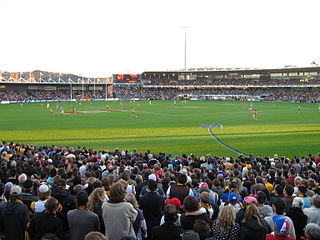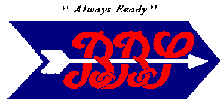
Scouting, also known as the Scout Movement, is a worldwide youth social movement employing the Scout method, a program of informal education with an emphasis on practical outdoor activities, including camping, woodcraft, aquatics, hiking, backpacking, and sports. Another widely recognized movement characteristic is the Scout uniform, by intent hiding all differences of social standing in a country and encouraging equality, with neckerchief and campaign hat or comparable headwear. Distinctive uniform insignia include the fleur-de-lis and the trefoil, as well as merit badges and other patches.

Launceston is a city in the north of Tasmania, Australia, at the confluence of the North Esk and South Esk rivers where they become the Tamar River (kanamaluka). As of 2021, the Launceston urban area has a population of 90,953. Launceston is the second most populous city in Tasmania after the state capital, Hobart. Launceston is the fifth-largest inland city and the ninth-largest non-capital city in Australia. Launceston is regarded as the most livable regional city, and was one of the most popular regional cities to move to in Australia from 2020 to 2021. Launceston was named Australian Town of the Year in 2022.
The history of Tasmania begins at the end of the Last Glacial Period when it is believed that the island was joined to the Australian mainland. Little is known of the human history of the island until the British colonisation of Tasmania in the 19th century.

The Scout Motto of the Scout movement is, in English, "Be Prepared", with most international branches of the group using a close translation of that phrase. These mottoes have been used by millions of Scouts around the world since 1907. Most of the member organizations of the World Association of Girl Guides and Girl Scouts (WAGGGS) share the same mottoes.

Scouts Australia is a trading name of The Scout Association of Australia, which is the largest scouting organisation in Australia, claiming 48,796 children and youths and 2,792 young adult participants in 2022, and is a member of the World Organization of the Scout Movement. It was formed in 1958 and incorporated in 1967. It operates personal development programs for children and young adults from 5 to 25 years of age with programs successively opened to girls after 1971.
Scouting started in Victoria, Australia, as early as 1907 and local Boy Scout patrols and troops formed independently. Several separate central organisations began operating including Boys' Brigade Scouts, Church Lads' Brigade Scouts, Chums Scouts, Imperial Boy Scouts, Girl Peace Scouts, Imperial Boy Scouts Victoria Section, Imperial Boy Scouts Victorian Section, Gippsland Boy Scouts Association, Australian Boy Scouts, Australian Imperial Boy Scouts, The Boy Scouts Association, Life-Saving Scouts of the Salvation Army and Methodist Boy Scouts.
Scouting in South Australia began in 1908.

Scouting and Guiding in Queensland is represented by Scouts Australia, Girl Guides Australia, Plast Ukrainian Scouts, and the Australian Baden-Powell Scouts' Association.
Scouting started in New South Wales, a State of Australia, in 1908. In the early years, local Boy Scout patrols and troops formed independently and several separate associations began operating including the Chums Scout Patrols, League of Boy Scouts, Girl Peace Scouts, Boys Brigade Scouts and Church Lads Brigade Scouts. These were later joined by The Boy Scouts Association, The Girl Guides Association and Life-Saving Scouts and Life Saving Guards of the Salvation Army. Some local Scout groups moved affiliation between the different associations.

Australian rules football has been played in Tasmania since the late 1860s. It draws the largest audience for any football code in the state. A 2018 study of internet traffic showed that 79% of Tasmanians are interested in Australian rules football, the highest rate in the country.

Throughout the world there are many museums related to Scouting dedicated to preserving, communicating, and exhibiting the heritage of the Scouting movement for purposes of study, education, and enjoyment of society. A downloadable world directory of Scouting museums is available from the US Scouting Service Project.
The Scout and Guide movement in Australia consists of:
The Scout and Guide movement in New Zealand is served by

Scouting for Boys: A handbook for instruction in good citizenship is a book on Boy Scout training, published in various editions since 1908. Early editions were written and illustrated by Robert Baden-Powell with later editions being extensively rewritten by others. The book was originally a manual for self-instruction in observation, tracking and woodcraft skills as well as self-discipline and self-improvement, about the British Empire and duty as citizens with an eclectic mix of anecdotes and unabashed personal observations and recollections. It is pervaded by a degree of moral proselytizing and references to the author's own exploits. It is based on his boyhood experiences, his experience with the Mafeking Cadet Corps during the Second Boer War at the siege of Mafeking, and on his experimental camp on Brownsea Island, England.

The British Boy Scouts and British Girl Scouts Association is an early scouting organisation, having begun as the Battersea Boy Scouts in 1908. The organisation was renamed as the British Boy Scouts and launched as a national organisation on 24 May 1909. In association with other Scout organisations, the BBS formed the National Peace Scouts in 1910. The BBS instigated the first international Scouting organisation, the Order of World Scouts in 1911.

The Colony of Tasmania was a British colony that existed on the island of Tasmania from 1856 until 1901, when it federated together with the five other Australian colonies to form the Commonwealth of Australia. The possibility of the colony was established when the Parliament of the United Kingdom passed the Australian Constitutions Act in 1850, granting the right of legislative power to each of the six Australian colonies. The Legislative Council of Van Diemen's Land drafted a new constitution which they passed in 1854, and it was given royal assent by Queen Victoria in 1855. Later in that year the Privy Council approved the colony changing its name from "Van Diemen's Land" to "Tasmania", and in 1856, the newly elected bicameral parliament of Tasmania sat for the first time, establishing Tasmania as a self-governing colony of the British Empire. Tasmania was often referred to as one of the "most British" colonies of the Empire.
In the Australian state of Tasmania, there are many areas which are commonly known by regional names. Regions are areas that share similar characteristics. These characteristics may be natural such as the Furneaux Islands, the coastline, or the Central Highlands. Alternatively, the characteristics may be cultural, such as a viticulture land use. Tasmania is divided by numerous regional boundaries, based on different characteristics. In many cases boundaries defined by different government agencies are coterminous and are often cited by the Australian and local media that tend to distinguish between North West, West Coast, Southern, and East Coast.

Lookwide Camp is recognised as the first official Scout camp. From 22 August to 4 September 1908, Baden-Powell ran a camp near Humshaugh, England. While Brownsea Island was the site of the experimental camp run by Baden-Powell in 1907, the Humshaugh camp had thirty Boy Scouts from around the United Kingdom who were members of recognised Scout Troops who followed the Scout Method and Scout Law as developed by Baden-Powell and published in his Scouting for Boys.











